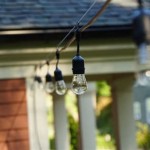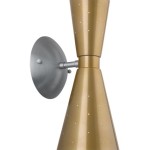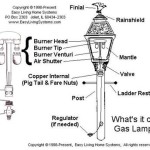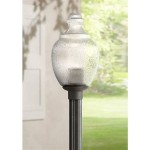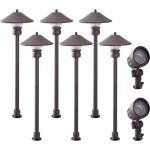Motion Sensing Outdoor Security Lights: An In-Depth Guide
Motion sensing outdoor security lights represent a significant advancement in home security technology, offering a proactive approach to deterring potential intruders and enhancing personal safety around residential properties. These lights are designed to automatically illuminate when movement is detected within their designated range, providing immediate visibility and potentially startling anyone approaching the property with malicious intent. This article offers a comprehensive overview of motion sensing outdoor security lights, exploring their functionalities, benefits, types, installation considerations, and maintenance requirements.
The primary function of a motion sensing security light is to activate upon detecting movement. This is achieved through the use of various sensor technologies, the most common being passive infrared (PIR) sensors. PIR sensors detect changes in infrared radiation emitted by objects within their field of view. When a warm object, such as a person or animal, moves into the sensor's range, it triggers the light to turn on. Other sensor types, such as microwave sensors, emit microwave radiation and detect changes in the reflected signal caused by moving objects. These sensors are generally more sensitive than PIR sensors and can detect movement through walls and other obstacles, although this can also lead to false alarms. Dual-technology sensors combine PIR and microwave technology, reducing the likelihood of false alarms by requiring both sensors to be triggered simultaneously.
The effectiveness of a motion sensing security light depends on several factors, including the sensor's range, sensitivity, and detection angle. The range determines how far the sensor can detect movement, while the sensitivity determines how small of a temperature change or movement is required to trigger the light. The detection angle defines the area within which the sensor is active. Adjusting these settings appropriately is crucial to optimize performance and minimize false alarms. For example, reducing the sensitivity can prevent the light from being triggered by small animals or swaying branches. Similarly, adjusting the detection angle can limit the area covered by the sensor, preventing it from being triggered by activity on a neighboring property.
Understanding the Benefits of Motion Sensing Security Lights
The advantages of installing motion sensing outdoor security lights are multifaceted, extending beyond simple illumination. They contribute significantly to crime deterrence, energy efficiency, and overall safety.
One of the most significant benefits is their ability to deter crime. The sudden burst of light can startle potential intruders, making them aware that they have been detected and discouraging them from proceeding further. This is particularly effective in areas that are typically dark or secluded, as the increased visibility eliminates hiding places and makes it more difficult for criminals to operate unnoticed. Furthermore, the presence of security lights can signal to potential burglars that the property is well-protected, making it less attractive as a target.
Motion sensing lights also contribute to energy efficiency. Unlike conventional outdoor lights that remain on continuously, these lights only activate when needed. This reduces energy consumption and lowers electricity bills. In many cases, motion sensing lights can be equipped with adjustable timers, allowing users to set the duration for which the light remains on after being triggered. This further optimizes energy usage by ensuring that the light only stays on for as long as necessary. The use of LED bulbs in motion sensing lights further enhances energy efficiency, as LEDs consume significantly less power than traditional incandescent or halogen bulbs.
Beyond crime deterrence and energy savings, motion sensing lights enhance personal safety. They provide illumination in areas where it is needed most, such as walkways, driveways, and entryways, reducing the risk of slips, trips, and falls. This is particularly important for elderly individuals or those with mobility issues. The lights also provide added security for residents returning home at night, ensuring that they can safely navigate their property without fear of encountering an unexpected intruder. The increased visibility also allows residents to identify potential hazards, such as obstacles in the pathway or suspicious activity in the neighborhood.
Types of Motion Sensing Outdoor Security Lights
The market offers a wide variety of motion sensing outdoor security lights, each with its own unique features and functionalities. Understanding the different types available is crucial for selecting the most appropriate option for a specific application.
One common type is the standalone motion sensing light. These units typically consist of a light fixture with an integrated motion sensor. They are relatively easy to install and can be powered by either hardwired connections or batteries. Hardwired models offer a more reliable power source and are suitable for locations where electrical wiring is readily accessible. Battery-powered models, on the other hand, offer greater flexibility in terms of placement and are ideal for areas where wiring is not feasible. However, battery-powered models require periodic battery replacement, which can be an ongoing expense.
Another type is the integrated security system with motion sensing lights. These systems typically include a central control panel, multiple sensors, and one or more lights. The sensors can be placed around the perimeter of the property to detect movement and trigger the lights. Integrated systems often offer additional features, such as alarm sirens, remote monitoring capabilities, and smartphone integration. These systems provide a comprehensive security solution for homeowners who want maximum protection.
Solar-powered motion sensing lights represent an increasingly popular option due to their energy efficiency and environmental friendliness. These lights are equipped with solar panels that collect sunlight during the day and store it in rechargeable batteries. At night, the batteries power the light when motion is detected. Solar-powered lights are easy to install and require no wiring, making them ideal for remote locations or areas where electrical access is limited. However, their performance can be affected by weather conditions, and they may not be as bright as hardwired or battery-powered models.
Floodlights are a popular choice for security lighting due to their wide beam angle and high light output. Motion sensing floodlights are typically used to illuminate large areas, such as driveways, backyards, and parking lots. They are available in various wattages and can be fitted with different types of bulbs, including LED, halogen, and incandescent. LED floodlights are the most energy-efficient option, offering long lifespan and low power consumption.
Installation and Maintenance Considerations
Proper installation and regular maintenance are essential for ensuring the optimal performance and longevity of motion sensing outdoor security lights.
Before installing a motion sensing light, it is crucial to carefully consider the location. The light should be placed in a location that provides maximum coverage of the area to be protected. It should also be positioned in a way that minimizes the risk of false alarms. Avoid placing the light near heat sources, such as air conditioners or vents, as these can trigger the sensor. Similarly, avoid placing the light near trees or bushes, as swaying branches can also cause false alarms. The light should be mounted securely to prevent it from being dislodged by wind or other weather conditions.
For hardwired models, it is important to follow all applicable electrical codes and safety regulations. If you are not comfortable working with electrical wiring, it is recommended to hire a qualified electrician to perform the installation. Disconnecting the power supply before beginning any electrical work is vital to prevent electric shock.
Regular maintenance is required to keep motion sensing lights functioning properly. This includes cleaning the sensor lens to remove dirt and debris, which can interfere with its ability to detect movement. The bulbs should also be checked periodically and replaced as needed. For battery-powered models, the batteries should be replaced regularly to ensure reliable operation. Checking the wiring connections for corrosion or damage should be part of the maintenance routine, especially for hardwired models.
Adjusting the sensitivity and range settings of the sensor is important to optimize performance and minimize false alarms. The sensitivity should be adjusted to a level that allows the light to be triggered by human movement but ignores smaller objects, such as animals or leaves. The range should be adjusted to cover the desired area without being triggered by activity on neighboring properties. The timer setting, which determines how long the light stays on after being triggered, should also be adjusted to conserve energy.
For solar-powered models, ensuring that the solar panel is clean and free of obstructions is crucial for optimal charging. The panel should be positioned in a location that receives direct sunlight for several hours each day. The battery should also be replaced periodically to maintain its charging capacity.
Addressing intermittent light activations requires systematic troubleshooting. Initially, inspect the sensor lens for accumulated dirt or obstructions that might trigger false positives. Further, assess the surrounding environment for potential sources of interference such as moving foliage from trees, or reflections from nearby vehicles. If these are present, adjusting the sensor sensitivity or repositioning the light may resolve the issue. If the light is powered by batteries, ensure they are fresh. If the problem persists, a qualified electrician should examine the wiring, particularly for hardwired models, to identify any potential short circuits or loose connections. Moreover, reviewing the light's operational settings, such as the detection range and light duration, according to the manufacturer's instructions is another method to address erratic behavior.

Defiant 180 Degree Motion Sensor White Outdoor Security Light Df 5416 Wh A The Home Depot

Auraglow Pir Motion Sensor Up Down Outdoor Wall Security Light Warminster Stainless Steel Led Lighting

Best Outdoor Motion Sensor Lights 2024 Security

Lepro Motion Sensor Outdoor Light Led Security Flood Lights With 3 Adjustable Heads 270 Wide Lighting Angle 27w 3200lm Super Bright Ip65 Waterproof For Yard Porch Garage Black Com

All Pro 180 Degree Broe Motion Activated Sensor Outdoor Security Flood Light With Lamp Cover Ms185r The Home Depot

Leonlite Led Security Light Motion Sensor Flood Lights Outdoor Dusk To Dawn Detector 3 Modes Adjustable 2 Head Ip65 Waterproof 20w 150w Equiv 5000k Daylight Etl Listed White Newegg Com

Lightdot Led Security Lights Motion Sensor Light Outdoor 38w 3800lm O

Best Outdoor Motion Sensor Lights 2024 Security

28w Outdoor Security Lights With Motion Sensor And Dusk To Dawn Lightdot

Preston 6 1 2 High Matte Black Led Motion Sensor Security Light 66f20 Lamps Plus
Related Posts
